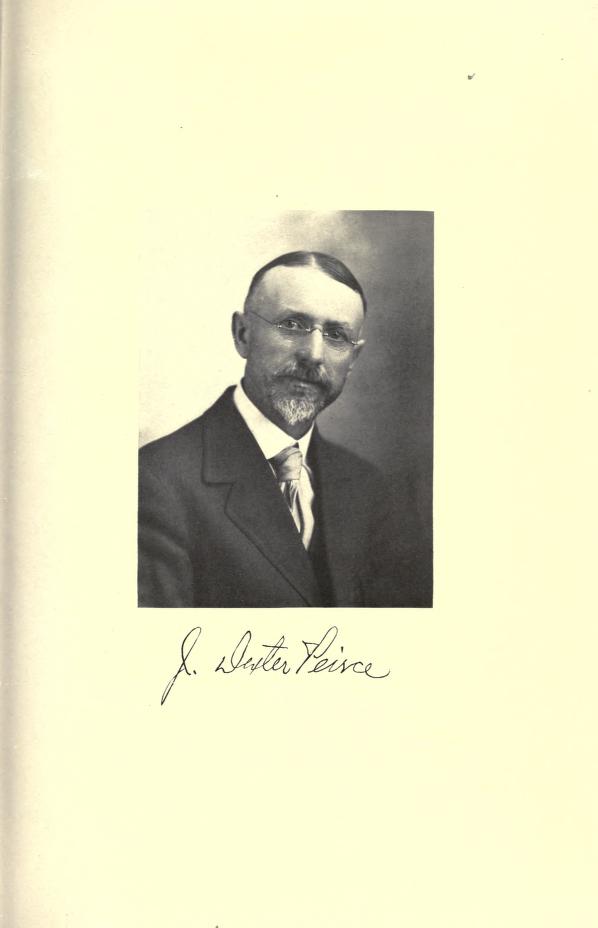Joseph Dexter Peirce, a progressive and engaged citizen of Larimore, North Dakota, was born on December 5, 1857, in Newburgh, New York. He was the son of Henry T. and Mary E. (Chapman) Peirce. Educated in Newburgh’s public schools, Phillips Exeter Academy, Heighland Institute, and Eastman’s Business College, Peirce initially worked in a New York dry goods house. In 1883, he moved to Cass County, North Dakota, and later bought a farm near Larimore. In 1896, he started a successful real estate, loan, and insurance business. An active Republican, Peirce served in the state legislature and held various local offices. He was deeply involved in civic and fraternal organizations and played a key role in organizing farmers’ institutes and promoting good roads in North Dakota.
Joseph Dexter Peirce, a progressive and engaged citizen of Larimore, North Dakota, was born on December 5, 1857, in Newburgh, New York. He is the son of Henry T. and Mary E. (Chapman) Peirce. After completing his preliminary studies in the public schools of Newburgh, he attended Phillips Exeter Academy for a short period. He then pursued the study of Latin and Greek at Heighland Institute in Newburgh under Professor Merryfield, who later became the president of the University of North Dakota. Peirce concluded his education with a course of study at Eastman’s Business College in Poughkeepsie.
His ambition was to attend and graduate from Harvard College, but due to ill health and a naturally delicate constitution, he was compelled to abandon his aspirations and instead chose to make North Dakota his home. Prior to this, however, he spent three years working as a clerk at the dry goods jobbing house of Heazen, Todds & Company in New York. In the spring of 1883, he ventured to Cass County, North Dakota, and acquired a relinquishment of a claim near Hunter. He sold this claim in early 1885 and purchased a large and excellent farm approximately six miles north of Larimore. For eleven years, he successfully engaged in stock raising and grain growing on the farm.
In the spring of 1896, Mr. Peirce relocated to the village of Larimore and established a thriving real estate, loan, and insurance business. He has been actively involved in local politics and is recognized as a prominent progressive Republican. He was elected to serve in the third legislative assembly of the state, where he assumed the role of chairman of the committee on engrossing and served as a member of the committees on judiciary, education, agriculture, immigration, apportionment, and the joint standing committee on joint rules. Additionally, he has held positions as city treasurer, assessor, and police magistrate.
Peirce is actively engaged in numerous fraternal and civic organizations. He is a member of North Star Lodge No. 16, Ancient Free and Accepted Masons, North Star Chapter No. 32, O.E.S., and the Commercial Club. He played a pivotal role in organizing the Larimore fire department and currently serves as the assistant chief. As the chairman of the good roads committee of the Commercial Club, he initiated and successfully organized the first state good roads convention, which took place in Larimore on June 3, 1908.
Mr. Peirce exhibits a particular interest in farmers’ institutes and holds the position of president of the Western Grand Forks County Farmers’ Institute Association. With the assistance of the late Thomas F. Eastgate, he overcame numerous obstacles and discouragements to establish the second farmers’ institute in the state. This institution, now recognized as the largest and most popular in the state, second only to the grain growers’ convention in Fargo, hosts a midwinter fair and significantly influences and benefits farming communities throughout North Dakota. The tremendous success of the institution is largely attributed to the relentless and effective work of Mr. Peirce.
Source
C.F. Cooper & Company, History of the Red River Valley, Past And Present: Including an Account of the Counties, Cities, Towns And Villages of the Valley From the Time of Their First Settlement And Formation, volumes 1-2; Grand Forks: Herald printing company, 1909.

